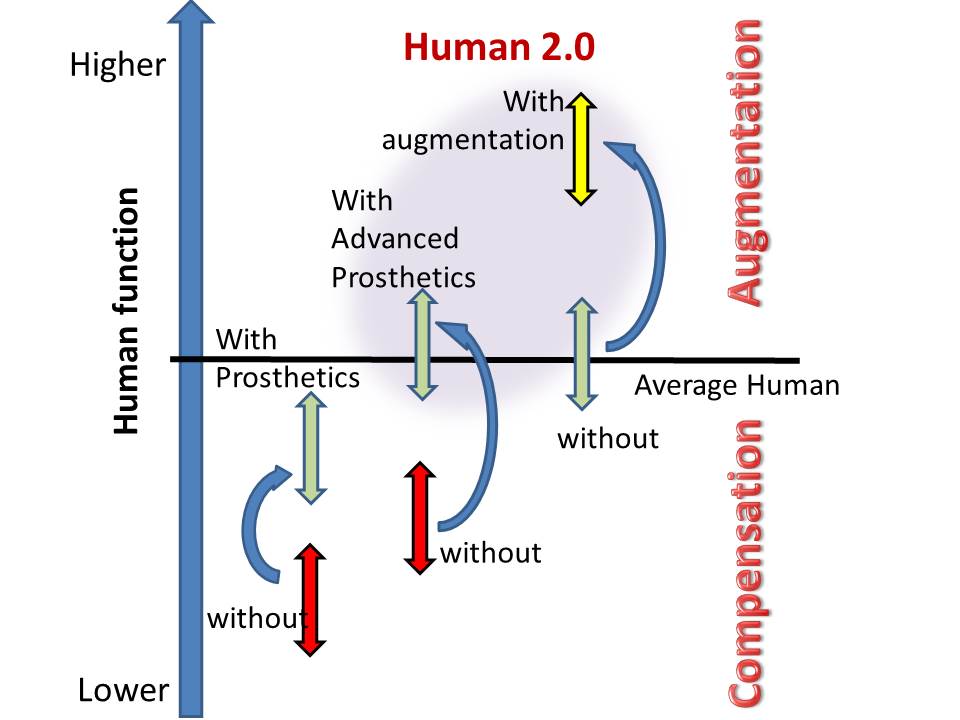Skip to content
Vision
Over many centuries the human has been extending their physical, cognitive, and social abilities in all activities. Every major technological breakthrough in the history made the human more capable, which changed the life style and the society. These changes have been many orders of magnitude faster than evolutional changes. Yet, the changes will be even more accelerated with a new generation of wearable, implantable, and prosthetics technologies that directly augment the human abilities in broad function. In the near future, we envision that the human will gain unprecedented-level physical, cognitive, and social abilities, becoming a new type of technological creature, which we call “Human 2.0”.

Robotics is among the key enabling technologies to the creation of Human 2.0. Physical prosthetic devices, exoskeletons and powered suites, wearable sensors, implantable devices, and visual and hearing aids are just a few examples of the technologies that have been developed within the robotics community and its collaborators. These devices are primarily for compensating for certain disabilities and abnormalities targeted for a certain patient population. However, the technology has been developed further and is reaching a turning point where the wearers of the devices can exceed the performance of average people. We have already seen that a handicapped athlete can run faster and a longer distance with simple augmentation devices. The technology is being extended from compensation to augmentation and enhancement.

We have also seen new types of wearable robots that provide the wearer with extra limbs. These supernumerary robotic limbs have emerged to augment the human function in manipulation and locomotion, streamlining task execution, increasing power and strength, improving dexterity, and reducing fatigue and injuries. New types of brain-robot communication and cognitive prosthetics are also pointing in the future direction of human augmentation.

The objective of this workshop is bring together active researchers and practitioners in robotics and diverse cross-disciplinary fields, including rehabilitation, biomechanics, neurology, and cognitive sciences to display the state-of-the-art and address future directions and cross-disciplinary collaborations.
Final Program
8:10 am Opening Remark, Organizer: H. Harry Asada, MIT
8:20 am Human 2.0: Vision and Challenges, Hugh Herr, MIT
9:00 am “Recovery of Function after Severe Spinal Cord Injury by Spinal Stimulation”, Joel Burdick, Cal Tech
9:40 am “Wearable Extra Fingers, Arms, and Legs: Potentials and Challenges”, H. Harry Asada, MIT
10:20 am Coffee Break
10:40 am “Human Performance Augmentation Based on Physiological Measures during Haptic Interaction with a Co-Robot”, Jun Ueda, Georgia Tech
11:20 am Discussion, Moderator: Hugh Herr, Discusser/Short-Presenter: Tamar Makin, Oxford University
12:20 pm Lunch Break
1:20 pm “Soft Wearable Robots to Assist Manipulation and Mobility”, Conor Walsh, Harvard University
2:00 pm “Lower-Limb Exoskeletons, Touching on Emulator Systems, Human-in-the-Loop Optimization, and Unpowered Devices”, Steve Collins, CMU
2:40 pm “Binaural Stimulation for Working Memory Enhancement for Alzheimer Patients”, Alexander Leonessa, Virginia Tech
3:20 pm Coffee Break
3:40 pm “On the Design of Limb Exoskeletons for Metabolic Augmentation”, Hugh Herr, MIT
4:20 pm Debate and Final Discussion, Moderator: H. Harry Asada, Discusser/Short-Presenter, Vittorio Caggiano, Karolinska Institute
5:20 pm Adjourn


